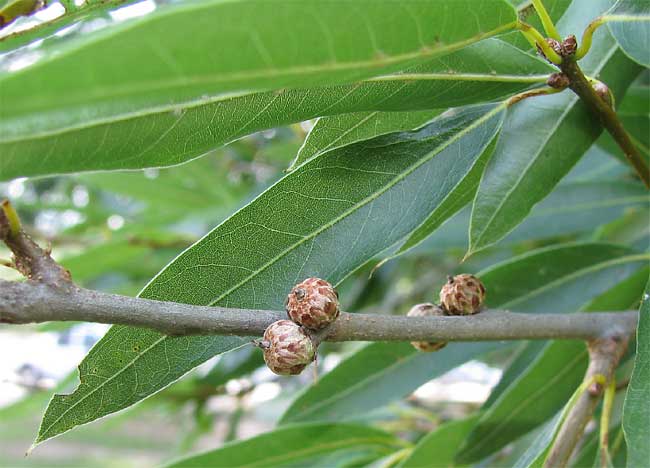Excerpts from Jim Conrad's
Naturalist Newsletter

from the the July 13, 2008 Newsletter, written in northern Mississippi:
WILLOW OAKS
At a rest area in northern Mississippi we took a break beneath a large, sturdy shadetree bearing immature acorns on its branches, and with deciduous, slender, unlobed leaves rather like those of a willow. In fact, it was a Willow Oak, QUERCUS PHELLOS. You can see willowy leaves, immature acorns, and buds above.
In the US Southeast most oak leaves are variously lobed and indented, so anyone in this area meeting a Willow Oak for the first time is bound to think of it as unusual because of its willow-like leaves. If you meet this tree and it's so young that it bears no acorns, how can you convince yourself that it's really an oak?
The quickest way is to notice the buds. In the picture, up at the top right, notice how the buds cluster toward the twig's tip. In most tree species buds are more evenly distributed along the twigs. Also, if you look closely at the buds themselves, they're covered with numerous overlapping bud scales. Many tree buds have markedly fewer scales or no scales at all.
In the wild, Willow Oaks are typical of bottomland soils of the US Southeast. However someone discovered that they can survive in cities, so today sometimes you find long rows of them along streets and providing shade and greenness in isolated little dirt-islands in vast parking lots at malls.
In our area oak species fall into one of two great subdivisions, the red and white oaks. Red oak leaves are bristle-tipped, the trees' acorns need two years in which to mature, acorn cups are velvety inside, and the acorns root in the spring. White oak leaves lack bristles, acorns mature in only a year, acorn cups are smooth inside, and acorns root in the fall. So, into which group does the Willow Oak fall?
In the picture you can see that leaf tips end in a single sharp bristle, so that's enough to prove that it falls in the red oak group.